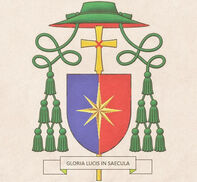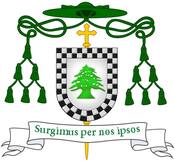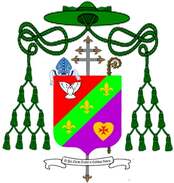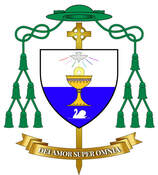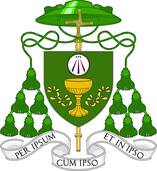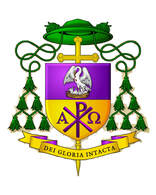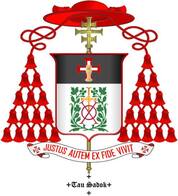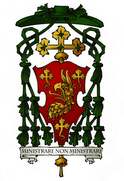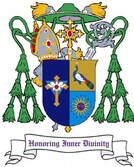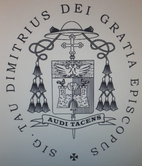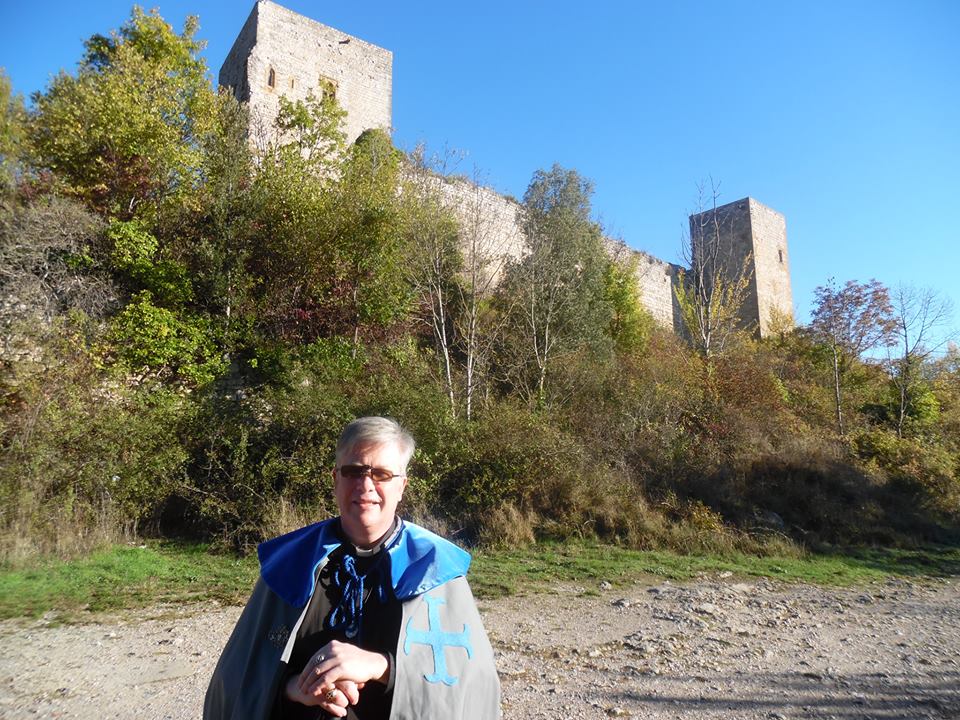2021, Year of the Laurel - Canonisations
"Al cap des setzt cent ans, verdajara lo laurèl"
“In 700 years the laurel will become green again, good people will return”
Guilhèm Belibasta
“In 700 years the laurel will become green again, good people will return”
Guilhèm Belibasta

On the 4th of July 2021, being the 5th Sunday after Trinity, the following three people will be canonised by bishops of the Holy Celtic Order of the Temple: Esclarmonda de Fois, Guilhèm Belibasta and Raimond-Roger Trencavel. Please see brief biographies below. We have deliberately chosen to use the Occitan spellings of their names as Occitan was their mother tongue, rather than French.
Esclarmonda was truly a saint, a Parfaite known for her charity to the poor and sick, as well as her deep spirituality. Guilhèm and Raimond-Roger were men of the world, and despite Guilhèm’s staus as a Parfait he was arguably the least perfect Parfait in Cathar history, however, like Raimond-Roger he was a martyr for his faith and martyrdom for the Christian faith confers immediate sainthood regardless of personal short-comings and ecclesial jurisdiction. Some might argue that Raimond-Roger was a Catholic and not, officially at least, a Cathar Credent. Even if that were the case, as seems likely, he was certainly a Bonhomme who gave shelter to Cathars, sympathised with their cause and resisted the evil forces of the Roman Inquisition. (Ⲧ Blaise)
Esclarmonda was truly a saint, a Parfaite known for her charity to the poor and sick, as well as her deep spirituality. Guilhèm and Raimond-Roger were men of the world, and despite Guilhèm’s staus as a Parfait he was arguably the least perfect Parfait in Cathar history, however, like Raimond-Roger he was a martyr for his faith and martyrdom for the Christian faith confers immediate sainthood regardless of personal short-comings and ecclesial jurisdiction. Some might argue that Raimond-Roger was a Catholic and not, officially at least, a Cathar Credent. Even if that were the case, as seems likely, he was certainly a Bonhomme who gave shelter to Cathars, sympathised with their cause and resisted the evil forces of the Roman Inquisition. (Ⲧ Blaise)
Prayer of the Holy Cathar Martyrs
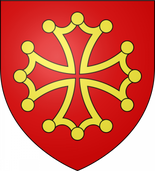
O Lord Remember, Holy Esclarmonda de Fois, Holy Guilhèm Belibasta, Holy Raimond-Roger Trencavel, and all Thy Holy Cathar Martyrs. Remember those who did not adore the Beast and whom the Beast slayed, Thy Perfecti, who lived in an age when the right to seek Thee was bought with their lives. Remember all those in their honour who have lost their lives for their faith and conscience. In Thine endless clemency O Lord have mercy on all the burned ones and persecuted ones of this world. Let the enemies of faith and freedom be confounded and let the Light of Thy tolerance dwell in the heart of all mankind. Amen.
St Esclarmonda de Fois, Parfaite
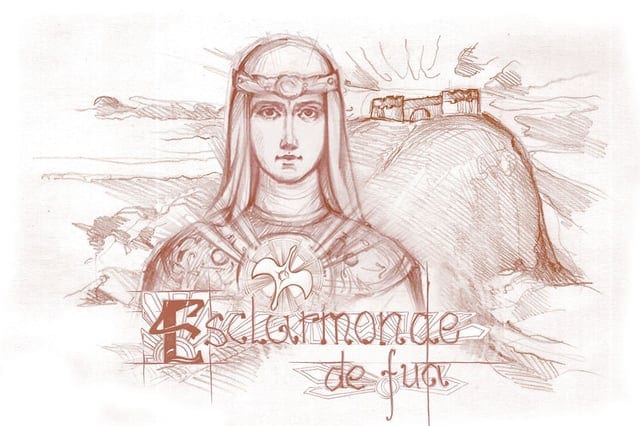
“Esclarmonde of Foix (French: Esclarmonde de Foix; Occitan: Esclarmonda de Fois), was a prominent figure associated with Catharism in thirteenth century Occitania (in the south of modern-day France).
Her biography is difficult to establish since several noblewomen in the same area at the same time had the same rare first name. The name Esclarmonde means "clarity of the world" in the Occitan language.
Family
Esclarmonde of Foix was the daughter of Roger Bernard I, Count of Foix, and Cécile Trencavel, daughter of Raymond I Trencavel. Raymond-Roger of Foix, Count of Foix was her brother. In 1175, she married Jourdain III, lord of L'Isle-Jourdain. They had 6 children: Bernard-Jourdain de l'Isle-Jourdain, the eldest and heir, Escaronia, Obica, Jordan, Othon-Bernard, Philippa.
Spiritual life
Esclarmonde was widowed in October 1200 and turned to Catharism sometime thereafter. Catharism was a form of Christianity which had developed in southern France at that time, and which was seen as heresy by the Catholic church.
She received the Cathar sacrament, the consolamentum, for becoming a Cathar Perfect from the Cathar bishop Guilhabert de Castres in 1204 in Fanjeaux along with three other women of high rank, Aude de Fanjeaux, Fays de Durfort, and Raymonde of Saint-Germain. The ceremony was conducted in the presence of her brother, Raymond-Roger of Foix.
She settled in Pamiers and was probably involved in an initiative to rebuild the fortress of the Château de Montségur. She participated in the Conference of Pamiers of 1207, which followed the Conference of Montreal of the previous year. It was the last debate between the Cathars and the Roman Catholic Church, represented by Dominic Guzman, founder of the Dominican order and later known as "Saint" Dominic, and Diego de Acebo, the bishop of Osma.
The following year, in 1208, Pope Innocent III launched the Albigensian Crusade against the Cathars after the murder of his delegate Pierre de Castelnau.” (wikipedia)
Some believe that on the day of the martyrdom of the Cathars of Montségur (16th March, 1244), the Bonne Dame Esclarmonde de Pereille ascended into the heavens in the form of a dove while holding the Holy Grail in her claws. When the mountain beneath her opened up to receive the Grail she then dropped the Holy Grail into the mountain, after which the mountain closed again.
(for the Holy Eucharist on the 10th of August, the feast of St Esclarmonda, the Common of Virgins would be appropriate)
Her biography is difficult to establish since several noblewomen in the same area at the same time had the same rare first name. The name Esclarmonde means "clarity of the world" in the Occitan language.
Family
Esclarmonde of Foix was the daughter of Roger Bernard I, Count of Foix, and Cécile Trencavel, daughter of Raymond I Trencavel. Raymond-Roger of Foix, Count of Foix was her brother. In 1175, she married Jourdain III, lord of L'Isle-Jourdain. They had 6 children: Bernard-Jourdain de l'Isle-Jourdain, the eldest and heir, Escaronia, Obica, Jordan, Othon-Bernard, Philippa.
Spiritual life
Esclarmonde was widowed in October 1200 and turned to Catharism sometime thereafter. Catharism was a form of Christianity which had developed in southern France at that time, and which was seen as heresy by the Catholic church.
She received the Cathar sacrament, the consolamentum, for becoming a Cathar Perfect from the Cathar bishop Guilhabert de Castres in 1204 in Fanjeaux along with three other women of high rank, Aude de Fanjeaux, Fays de Durfort, and Raymonde of Saint-Germain. The ceremony was conducted in the presence of her brother, Raymond-Roger of Foix.
She settled in Pamiers and was probably involved in an initiative to rebuild the fortress of the Château de Montségur. She participated in the Conference of Pamiers of 1207, which followed the Conference of Montreal of the previous year. It was the last debate between the Cathars and the Roman Catholic Church, represented by Dominic Guzman, founder of the Dominican order and later known as "Saint" Dominic, and Diego de Acebo, the bishop of Osma.
The following year, in 1208, Pope Innocent III launched the Albigensian Crusade against the Cathars after the murder of his delegate Pierre de Castelnau.” (wikipedia)
Some believe that on the day of the martyrdom of the Cathars of Montségur (16th March, 1244), the Bonne Dame Esclarmonde de Pereille ascended into the heavens in the form of a dove while holding the Holy Grail in her claws. When the mountain beneath her opened up to receive the Grail she then dropped the Holy Grail into the mountain, after which the mountain closed again.
(for the Holy Eucharist on the 10th of August, the feast of St Esclarmonda, the Common of Virgins would be appropriate)
St Guilhèm Belibasta, Parfait & Martyr
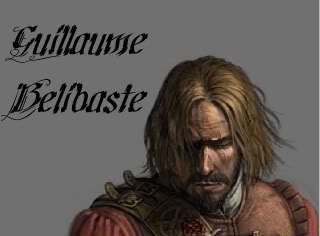 "The human heart is the true church of God" G.B.
"The human heart is the true church of God" G.B.
“Guillaume Bélibaste (occitan: Guilhèm Belibasta) is said to have been the last Cathar parfait in Languedoc. He was burned at the stake on the 24th of August 1321, as a result of the Inquisition at Pamiers led by Jacques Fournier (afterwards Pope Benedict XII). Much of Bélibaste's biography can be found in the pages of Emmanuel Le Roy Ladurie's Montaillou; although Bélibaste never lived at Montaillou, he is frequently mentioned in the interrogations of suspected heretics from Montaillou.
He was the son and namesake of Guillaume Bélibaste, a rich farmer at Cubières. After killing a shepherd, he had to leave Cubières and became a shepherd himself, and, in due course, a parfait. As a Cathar preacher, he was the pupil of Pierre and Jacques Authié. He eventually settled in the Kingdom of Valencia at Sant Mateu and then Morella in the Maestrazgo, where he made baskets and carding combs and became a mentor to a community of Cathars, some of whom had fled persecution in the Languedoc. Others migrated regularly between the two regions. One of the latter was Pierre Maury, a native of Montaillou.
He was the son and namesake of Guillaume Bélibaste, a rich farmer at Cubières. After killing a shepherd, he had to leave Cubières and became a shepherd himself, and, in due course, a parfait. As a Cathar preacher, he was the pupil of Pierre and Jacques Authié. He eventually settled in the Kingdom of Valencia at Sant Mateu and then Morella in the Maestrazgo, where he made baskets and carding combs and became a mentor to a community of Cathars, some of whom had fled persecution in the Languedoc. Others migrated regularly between the two regions. One of the latter was Pierre Maury, a native of Montaillou.
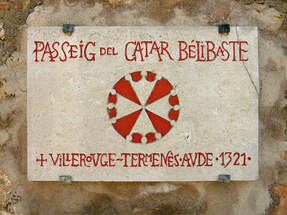
When, in 1320, his lover, Raymonde Piquier, became pregnant, Bélibaste persuaded Pierre Maury to marry her. Then, a few days later, he dissolved the marriage and salvaged his own reputation by making it appear the child was Maury's. Eventually he was betrayed by the spy Arnaud Sicre in the service of the Inquisition. Bélibaste was taken to Villerouge Termenes, interrogated and burnt at the stake there.” (wikipedia)
Before he died Guihèm prophesied that “In 700 years the laurel will become green again, good people will return”.
(for the Holy Eucharist on the 24th of August, the feast of St Guilhèm Belibasta,
the Common of Martyrs or the propers for Montségur Day would be appropriate)
Before he died Guihèm prophesied that “In 700 years the laurel will become green again, good people will return”.
(for the Holy Eucharist on the 24th of August, the feast of St Guilhèm Belibasta,
the Common of Martyrs or the propers for Montségur Day would be appropriate)
St Raimond-Roger Trencavel, Martyr
“Raymond Roger Trencavel (also Raimond, Occitan: Raimon Rogièr; 1185 – 10 November 1209) was a member of the noble Trencavel family. He was viscount of Béziers and Albi (and thus a vassal of the count of Toulouse), and viscount of Carcassonne and the Razès (and thus a vassal of the count of Barcelona, which was also ruling Aragon at this time).
Raymond-Roger was the son of Roger II Trencavel (d. 1194), and of Azalais of Toulouse (also known as the "Countess of Burlats"), daughter of Raymond V of Toulouse and sister of Raymond VI. Raymond-Roger was married to Agnes of Montpellier. His aunt, Beatrice of Béziers, was the second wife of Raymond VI of Toulouse.
Raymond-Roger lived in the Château Comtal in the fortified hill town of Carcassonne. The château was built by his ancestors in the 11th century. Raymond-Roger was not a Cathar, although many of his subjects were. He adopted a laissez-faire attitude to Catharism – and to other cultures and religions. He relied strongly on Jews to run Béziers, his second seat of power.
By mid-1209, at the beginning of the Albigensian Crusade, around 10,000 crusaders had gathered in Lyon and began to march south. In June, Raymond of Toulouse, recognizing the potential disaster at hand, promised to act against the Cathars, and his excommunication was lifted. The crusaders headed towards Montpellier and the lands of Raymond-Roger de Trencavel, aiming for the Cathar communities around Albi and Carcassonne. Like Raymond VI of Toulouse, Raymond-Roger de Trencavel sought an accommodation with the crusaders, but Raymond-Roger was refused a meeting and raced back to Carcassonne to prepare his defences. The city of Béziers was sacked in July and its population massacred.
Raymond-Roger was the son of Roger II Trencavel (d. 1194), and of Azalais of Toulouse (also known as the "Countess of Burlats"), daughter of Raymond V of Toulouse and sister of Raymond VI. Raymond-Roger was married to Agnes of Montpellier. His aunt, Beatrice of Béziers, was the second wife of Raymond VI of Toulouse.
Raymond-Roger lived in the Château Comtal in the fortified hill town of Carcassonne. The château was built by his ancestors in the 11th century. Raymond-Roger was not a Cathar, although many of his subjects were. He adopted a laissez-faire attitude to Catharism – and to other cultures and religions. He relied strongly on Jews to run Béziers, his second seat of power.
By mid-1209, at the beginning of the Albigensian Crusade, around 10,000 crusaders had gathered in Lyon and began to march south. In June, Raymond of Toulouse, recognizing the potential disaster at hand, promised to act against the Cathars, and his excommunication was lifted. The crusaders headed towards Montpellier and the lands of Raymond-Roger de Trencavel, aiming for the Cathar communities around Albi and Carcassonne. Like Raymond VI of Toulouse, Raymond-Roger de Trencavel sought an accommodation with the crusaders, but Raymond-Roger was refused a meeting and raced back to Carcassonne to prepare his defences. The city of Béziers was sacked in July and its population massacred.
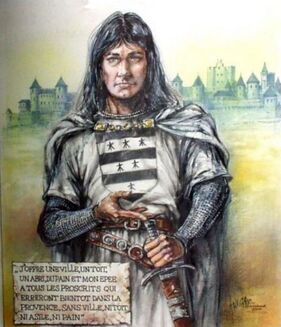
The town of Carcassonne was well fortified, but vulnerable and over-populated with refugees. The crusaders, led by a papal legate, Arnaud Amaury, Abbot of Cîteaux, arrived outside the town on 1 August 1209. As vassal of King Peter II of Aragon, Raymond-Roger had hoped for protection, but Peter was powerless to oppose Pope Innocent III's army and could act only as a mediator.
The siege did not last long. By 7 August the crusaders had cut the town's access to water. Raymond-Roger accepted a safe-conduct to negotiate terms of surrender in the Crusader camp. At the conclusion of these negotiations he was taken prisoner while still under safe conduct, and imprisoned in his own dungeon, where he died, possibly of dysentery, though there were suspicions of poisoning.
The town of Carcassonne had surrendered on 15 August. The inhabitants were not massacred but were forced to leave the town. Simon de Montfort was granted control of the area encompassing Carcassonne, Albi, and Béziers. Raymond-Roger's dispossessed son, Raymond II (1204-1263), formally ceded his rights to Louis IX of France in 1247, after several failed attempts to recover his patrimony.” (wikipedia)
(for the Holy Eucharist on the 10th of November, the feast of St Raimond-Roger Trencavel,
the Common of Martyrs would be appropriate)
The siege did not last long. By 7 August the crusaders had cut the town's access to water. Raymond-Roger accepted a safe-conduct to negotiate terms of surrender in the Crusader camp. At the conclusion of these negotiations he was taken prisoner while still under safe conduct, and imprisoned in his own dungeon, where he died, possibly of dysentery, though there were suspicions of poisoning.
The town of Carcassonne had surrendered on 15 August. The inhabitants were not massacred but were forced to leave the town. Simon de Montfort was granted control of the area encompassing Carcassonne, Albi, and Béziers. Raymond-Roger's dispossessed son, Raymond II (1204-1263), formally ceded his rights to Louis IX of France in 1247, after several failed attempts to recover his patrimony.” (wikipedia)
(for the Holy Eucharist on the 10th of November, the feast of St Raimond-Roger Trencavel,
the Common of Martyrs would be appropriate)
We, the undersigned bishops, being members of the Holy Celtic Order of the Temple, by authority of our Apostolic profession, unite in declaring Esclarmonda de Fois (Parfaite, Feast Day 10th August), Guilhem Bélibasta (Parfait & Martyr, Feast Day 24th August) and Raimond-Roger de Trencavel (Credent & Martyr, Feast Day 10th November) canonised saints of the Gnosis. Given this day, the Fifth Sunday after Trinity, 2021.
Canonisation Homily - 4th July 2021
"2021 is an unusual year for many reasons, but for those of us who are members of the Holy Celtic Order of the Temple there is a special significance to this year as it is “the Year of the Laurel”, exactly 700 years since Guilhèm Belibasta, the last Cathar Perfect in Languedoc, prophesied that the Laurel tree, a symbol of Catharism, would flourish again after 700 years. In his exact words “In 700 years the laurel will become green again, good people will return”. In the Holy Celtic Order of the Temple we have decided to mark this special year with the formal canonisation of three “good people”, in chronological order: Raimond-Roger Trencavel, Esclarmonda de Fois and Guilhèm Belibasta. I am using the Occitan pronounciation of their names rather than the French, as they would have preferred.
Raimond-Roger Trencavel, Viscount of Carcassonne, is a wonderful example of a true liberal Catholic. Living many centuries before Liberal Catholicism as a movement began to evolve, nevertheless, he was a Catholic with a profoundly liberal and enlightened worldview, which was something of a rarity in the brutal Christendom of the middle ages, though admittedly less of a rarity in Occitania, which retained something of the sophistication of the ancient Roman Empire, without the barbarity; a culture which gave birth to the Troubadour tradition of poetry, song and romance; steeped in the Grail tradition and the heart-land of Catharism. Like many of the other nobility of Languedoc, Raimond-Roger understood Catharism and was sympathic towards it, as an alternative form of Christianity. Several of the nobility were Cathars themselves or had Cathar relatives, as we shall see.
After the bloody massacre of the citizens of Raimond Roger’s second city of Beziers, many Cathars took refuge in the capital of the Viscounty, Carcassonne where they were given shelter by Viscount Trencavel. The French Roman Catholic Crusaders then began to besige the city on the 1st of August and soon cut off its water supply. Raimond-Roger was offered safe conduct to meet with the leaders of the Crusade to negotiate terms of surrender however, he was taken prisoner and died in the dungeon of his own castle on the 10th of November the same year. He might have given over his Cathar and Jewish citizens to the Inquisition but he refused to do so and so as the model of a Good Christian Knight he gave his life to protect his people, and in the cause of religious liberty.
A contemporary and relative of Raimond-Roger; from the same noble stock, the Lady Esclarmonda de Fois was a daughter of the Count of Fois and wife of Lord Joudain II of L’Isle Jourdain. She was mother to six children and after becoming a widow in the year 1200 she became a Cathar Parfaite in 1204, in the presence of her brother, another Raimond-Roger, who was by this time the Count of Fois. Even before the start of the Albigensian Crusade Esclarmonda was conspicuously holy, a great mystic but also notable for her charity to the poor and sick. She might indeed be compared to the Franciscan tertiary, St Elisabeth of Hungary. After the tragedies of Beziers and Carcassonne, as a Cathar leader Esclarmonda played an important role in sheltering other Parfaits and probably also in preparing the castle of Montségur as a refuge for them. She was also involved in the Conference of Montreal in 1207, the last debate between the dreaded and dreadful Dominicans and the Cathars, before the Roman Church came up with their “final solution” to the Cathar threat to their spiritual supremacy.
It is not known when and where Esclarmonda died, but it was well before the fall of Montségur in 1244. A legend, however, quickly grew that on the day of the martyrdom of the Cathars of Montségur (16th March, 1244), the Bonne Dame Esclarmonda ascended into the heavens in the form of a dove while holding the Holy Grail in her claws. When the mountain beneath her opened up to receive the Grail she then dropped the Holy Grail into the mountain, after which the mountain closed again.
Finally, I would like to speak a little about Guilhém Belibasta, the last Cathar Perfect in Languedoc, who was burnt at the stake on the 24th August 1321. Whole volumes have been written about him and he was certainly an interesting character, who broke the mold of the chaste ascetic type of Parfait and was on the run in Catalonia for most of his unorthodox Cathar ministry. Rather than go into the details of Guilhèm’s life here I would like to read you an excerpt from a novel called “The Channel of the Grail: a novel of Cathars, Templars and a Nazi Grail Hunter” by Victor E. Smith, which I really feel gets the most salient point across very well.
Picture, if you will the nasty Bishop of Pamier and Inquisitor, Jacques Fournier, who later became the Pope Benedict XII. … In this fictional account Fournier believes that the Cathars possessed a spiritual treasure or source of spiritual power that the Church of Rome had lost and before he burnt the last Cathar Fournier was going to do his very best to re-possess that secret:
“The bishop quivered and then sniggered. “Suicide is a sin in my religion, and I’m certainly not ready to embrace yours. But” - he pointed his right index finger at Belibaste - “I shall still want to know the source of the power that imbues your people with the courage to choose the flames rather than say the few words required to recant.”
“Do you not know the Lord’s Prayer? Have you not read the Gospel of John?” Belibaste asked.
Fournier flushed. “What’s that got to do with it?”
Say it with meaning often enough and you too will regain the grace to console and be consoled. The Good God has made the sacrament available to everyone. No one robbed the church of the keys to the Kingdom of Heaven , Excellency. It tossed them away for the keys of the Roman Empire. That we, so-called heretics, have held on to them and used them across the centuries does not make them unavailable to you. Nor do we have to be deprived of them for your members to have them also. If, by the grace of God, the Gnostics and Cathars were chosen to preserve what the church wantonly discarded, what right does the church have to take that away from us? The Good God’s treasure does not exclude; it includes. in the end none will be damned; all will be saved. All is God’s creation so it cannot be otherwise. The one treasure that endures, the pearl of great price, is hidden in plain sight. He who has ears to hear, let him hear.”
Fournier shoved his large body back from the desk and stood, blood flushing his face. “I will not tolerate the words of the Saviour coming out of your blasphemous mouth. No more sermons from a heretical simpleton,” he gasped. “You want to be a martyr? So be it.” Out of breath he leaned on the desk. “Guards,” he shouted.
I welcome death. My consolation is in the flames,” Belibaste said calmly … “
That, my dear friends is why, I and eleven other Liberal Catholic and Gnostic bishops of our Order, are canonising these three Good Christians. In this 700th year since Guilhèm made his prophecy let us once more return to the primitive faith and lifestyle of Jesus and his Apostles, who healed, forgave, consoled, and preached nothing but universal salvation and a God of Love for all. These are very simple ideas accessible to any who have had their hearts broken open wide enough to receive them.
The feast days of our new saints are Esclarmonda, the 10th of August, Guilhèm Belibasta, the 24th of August and Raimond-Roger Trencavel, the 10th of November. May they accompany us on our journey towards true Gnosis." (Tau Blaise)
Raimond-Roger Trencavel, Viscount of Carcassonne, is a wonderful example of a true liberal Catholic. Living many centuries before Liberal Catholicism as a movement began to evolve, nevertheless, he was a Catholic with a profoundly liberal and enlightened worldview, which was something of a rarity in the brutal Christendom of the middle ages, though admittedly less of a rarity in Occitania, which retained something of the sophistication of the ancient Roman Empire, without the barbarity; a culture which gave birth to the Troubadour tradition of poetry, song and romance; steeped in the Grail tradition and the heart-land of Catharism. Like many of the other nobility of Languedoc, Raimond-Roger understood Catharism and was sympathic towards it, as an alternative form of Christianity. Several of the nobility were Cathars themselves or had Cathar relatives, as we shall see.
After the bloody massacre of the citizens of Raimond Roger’s second city of Beziers, many Cathars took refuge in the capital of the Viscounty, Carcassonne where they were given shelter by Viscount Trencavel. The French Roman Catholic Crusaders then began to besige the city on the 1st of August and soon cut off its water supply. Raimond-Roger was offered safe conduct to meet with the leaders of the Crusade to negotiate terms of surrender however, he was taken prisoner and died in the dungeon of his own castle on the 10th of November the same year. He might have given over his Cathar and Jewish citizens to the Inquisition but he refused to do so and so as the model of a Good Christian Knight he gave his life to protect his people, and in the cause of religious liberty.
A contemporary and relative of Raimond-Roger; from the same noble stock, the Lady Esclarmonda de Fois was a daughter of the Count of Fois and wife of Lord Joudain II of L’Isle Jourdain. She was mother to six children and after becoming a widow in the year 1200 she became a Cathar Parfaite in 1204, in the presence of her brother, another Raimond-Roger, who was by this time the Count of Fois. Even before the start of the Albigensian Crusade Esclarmonda was conspicuously holy, a great mystic but also notable for her charity to the poor and sick. She might indeed be compared to the Franciscan tertiary, St Elisabeth of Hungary. After the tragedies of Beziers and Carcassonne, as a Cathar leader Esclarmonda played an important role in sheltering other Parfaits and probably also in preparing the castle of Montségur as a refuge for them. She was also involved in the Conference of Montreal in 1207, the last debate between the dreaded and dreadful Dominicans and the Cathars, before the Roman Church came up with their “final solution” to the Cathar threat to their spiritual supremacy.
It is not known when and where Esclarmonda died, but it was well before the fall of Montségur in 1244. A legend, however, quickly grew that on the day of the martyrdom of the Cathars of Montségur (16th March, 1244), the Bonne Dame Esclarmonda ascended into the heavens in the form of a dove while holding the Holy Grail in her claws. When the mountain beneath her opened up to receive the Grail she then dropped the Holy Grail into the mountain, after which the mountain closed again.
Finally, I would like to speak a little about Guilhém Belibasta, the last Cathar Perfect in Languedoc, who was burnt at the stake on the 24th August 1321. Whole volumes have been written about him and he was certainly an interesting character, who broke the mold of the chaste ascetic type of Parfait and was on the run in Catalonia for most of his unorthodox Cathar ministry. Rather than go into the details of Guilhèm’s life here I would like to read you an excerpt from a novel called “The Channel of the Grail: a novel of Cathars, Templars and a Nazi Grail Hunter” by Victor E. Smith, which I really feel gets the most salient point across very well.
Picture, if you will the nasty Bishop of Pamier and Inquisitor, Jacques Fournier, who later became the Pope Benedict XII. … In this fictional account Fournier believes that the Cathars possessed a spiritual treasure or source of spiritual power that the Church of Rome had lost and before he burnt the last Cathar Fournier was going to do his very best to re-possess that secret:
“The bishop quivered and then sniggered. “Suicide is a sin in my religion, and I’m certainly not ready to embrace yours. But” - he pointed his right index finger at Belibaste - “I shall still want to know the source of the power that imbues your people with the courage to choose the flames rather than say the few words required to recant.”
“Do you not know the Lord’s Prayer? Have you not read the Gospel of John?” Belibaste asked.
Fournier flushed. “What’s that got to do with it?”
Say it with meaning often enough and you too will regain the grace to console and be consoled. The Good God has made the sacrament available to everyone. No one robbed the church of the keys to the Kingdom of Heaven , Excellency. It tossed them away for the keys of the Roman Empire. That we, so-called heretics, have held on to them and used them across the centuries does not make them unavailable to you. Nor do we have to be deprived of them for your members to have them also. If, by the grace of God, the Gnostics and Cathars were chosen to preserve what the church wantonly discarded, what right does the church have to take that away from us? The Good God’s treasure does not exclude; it includes. in the end none will be damned; all will be saved. All is God’s creation so it cannot be otherwise. The one treasure that endures, the pearl of great price, is hidden in plain sight. He who has ears to hear, let him hear.”
Fournier shoved his large body back from the desk and stood, blood flushing his face. “I will not tolerate the words of the Saviour coming out of your blasphemous mouth. No more sermons from a heretical simpleton,” he gasped. “You want to be a martyr? So be it.” Out of breath he leaned on the desk. “Guards,” he shouted.
I welcome death. My consolation is in the flames,” Belibaste said calmly … “
That, my dear friends is why, I and eleven other Liberal Catholic and Gnostic bishops of our Order, are canonising these three Good Christians. In this 700th year since Guilhèm made his prophecy let us once more return to the primitive faith and lifestyle of Jesus and his Apostles, who healed, forgave, consoled, and preached nothing but universal salvation and a God of Love for all. These are very simple ideas accessible to any who have had their hearts broken open wide enough to receive them.
The feast days of our new saints are Esclarmonda, the 10th of August, Guilhèm Belibasta, the 24th of August and Raimond-Roger Trencavel, the 10th of November. May they accompany us on our journey towards true Gnosis." (Tau Blaise)
Mass Propers
Collect
O Lord Remember, Holy Esclarmonda de Fois, Holy Guilhèm Belibasta, Holy Raimond-Roger Trencavel, and all Thy Holy Cathar Martyrs. Remember those who did not adore the Beast and whom the Beast slayed, Thy Perfecti, who lived in an age when the right to seek Thee was bought with their lives. Remember all those who in their honour, have lost their lives for their faith and conscience. In Thine endless clemency O Lord have mercy on all the burned ones and persecuted ones of this world. Let the enemies of faith and freedom be confounded and let the Light of Thy tolerance dwell in the heart of all mankind. Amen.
The lesson is taken from the sacred texts of the Cathars:
Holy Father, Thou just God of all good souls, Thou who art never deceived, who dost never lie or doubt, grant us to know what Thou knowest, to love what Thou dost love; for we are not of this world, and this world is not of us, and we fear lest we meet death in this realm of an alien god. Pharisees, seducers, you who sit at the gates of the Kingdom; you who hold back others who would enter, yet will not go in yourselves; and because of this I pray to the Holy Father of all good souls, who has the power of salvation, and through the merit of the saved causes our souls to germinate and flourish, and for the sake of the virtuous grants life to those in iniquity; the Holy Father who will continue to do so as long as there are good men in the world, till none of my little children are left. For all those that acknowledged the mastery of Lucifer, and fell from Paradise, and come from the seven kingdoms, they rose up on a sky of glass, and for every one that rose aloft, another fell and was lost; and for this cause God came down from heaven with the twelve apostles and took a phantom shape in Holy Mary.
The gospel is taken from the Interrogatio Iohannis, the Cathar Book of St John the Evangelist:
And the Son of God shall bring forth the elect out of the midst of the sinners and say unto them: Come, ye blessed of my Father, inherit the kingdom prepared for you from the foundation of the world. … And the Son of God shall walk with his elect above the firmament and shall shut up the devil, binding him with strong chains that cannot be loosed. At that time the sinners, weeping and mourning, shall say: O earth, swallow us up and cover us in death. And then shall the righteous shine as the sun in the kingdom of their Father. And he shall bring them before the throne of the invisible Father, saying: Behold, I and my children whom God hath given me. O righteous one, the world hath not known thee, but I have known thee in truth, because thou hast sent me. And then shall the Father answer his Son and say: My beloved Son, sit thou on my right hand until I make thine enemies the footstool of thy feet, … And then shall the Son of God sit on the right hand of his Father, and the Father shall command his angels, and they shall minister unto the righteous and set them among the choirs of the angels, to clothe them with incorruptible garments, and shall give them crowns that fade not and seats that cannot be moved. And God shall be in the midst of them; and they shall not hunger nor thirst any more, neither shall the sun light on them nor any heat. And God shall wipe away every tear from their eyes. And he shall reign with his holy Father, and of his kingdom there shall be no end for ever and ever.
Collect
O Lord Remember, Holy Esclarmonda de Fois, Holy Guilhèm Belibasta, Holy Raimond-Roger Trencavel, and all Thy Holy Cathar Martyrs. Remember those who did not adore the Beast and whom the Beast slayed, Thy Perfecti, who lived in an age when the right to seek Thee was bought with their lives. Remember all those who in their honour, have lost their lives for their faith and conscience. In Thine endless clemency O Lord have mercy on all the burned ones and persecuted ones of this world. Let the enemies of faith and freedom be confounded and let the Light of Thy tolerance dwell in the heart of all mankind. Amen.
The lesson is taken from the sacred texts of the Cathars:
Holy Father, Thou just God of all good souls, Thou who art never deceived, who dost never lie or doubt, grant us to know what Thou knowest, to love what Thou dost love; for we are not of this world, and this world is not of us, and we fear lest we meet death in this realm of an alien god. Pharisees, seducers, you who sit at the gates of the Kingdom; you who hold back others who would enter, yet will not go in yourselves; and because of this I pray to the Holy Father of all good souls, who has the power of salvation, and through the merit of the saved causes our souls to germinate and flourish, and for the sake of the virtuous grants life to those in iniquity; the Holy Father who will continue to do so as long as there are good men in the world, till none of my little children are left. For all those that acknowledged the mastery of Lucifer, and fell from Paradise, and come from the seven kingdoms, they rose up on a sky of glass, and for every one that rose aloft, another fell and was lost; and for this cause God came down from heaven with the twelve apostles and took a phantom shape in Holy Mary.
The gospel is taken from the Interrogatio Iohannis, the Cathar Book of St John the Evangelist:
And the Son of God shall bring forth the elect out of the midst of the sinners and say unto them: Come, ye blessed of my Father, inherit the kingdom prepared for you from the foundation of the world. … And the Son of God shall walk with his elect above the firmament and shall shut up the devil, binding him with strong chains that cannot be loosed. At that time the sinners, weeping and mourning, shall say: O earth, swallow us up and cover us in death. And then shall the righteous shine as the sun in the kingdom of their Father. And he shall bring them before the throne of the invisible Father, saying: Behold, I and my children whom God hath given me. O righteous one, the world hath not known thee, but I have known thee in truth, because thou hast sent me. And then shall the Father answer his Son and say: My beloved Son, sit thou on my right hand until I make thine enemies the footstool of thy feet, … And then shall the Son of God sit on the right hand of his Father, and the Father shall command his angels, and they shall minister unto the righteous and set them among the choirs of the angels, to clothe them with incorruptible garments, and shall give them crowns that fade not and seats that cannot be moved. And God shall be in the midst of them; and they shall not hunger nor thirst any more, neither shall the sun light on them nor any heat. And God shall wipe away every tear from their eyes. And he shall reign with his holy Father, and of his kingdom there shall be no end for ever and ever.
Please also see the Knights of St John the Baptist and Consolamentum pages!


